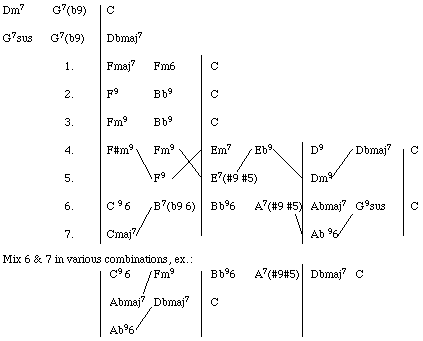Study Guide
Week 14
[ Reading ] [ Textbook ] [ Review ] [ New Material ] [ What You Should Know ] [ Homework ]
Reading
No textbook reading this week.
Review
Practice notating percussion parts.
New Material

This week we study different types of introductions and endings.
Introductions
Most introductions set the mood of the song and lead the listener to know what to expect of what will follow. Some introductions are more mysterious, and some lead to surprises. Good introductions and endings can make songs more interesting, and provide arrangers with a place to come up with something that was not done in another version.
Many times just the rhythm section starts the introduction, with a lead line coming in only when the main melody starts. Intros are usually 4 or 8 bars long. Most introductions end on a V chord to help set up the beginning of the head. There are many ways to construct introductions, and some of the following techniques are often used in combination:
- No intro: just start right in on the song.
- Pedal point. Put a series of different chords over a common pedal, usually ending on some form of the V chord.
- Use a turn around to make a 4-bar intro, or put two turnarounds together to make an 8-bar intro. Since most turnarounds end on V, these formulae work best when the song starts on the I chord.
- Use a repeating figure and write "Vamp until ready" over it, indicating that the melody will start on cue. This is used when you want to leave the length of the intro open, for example, to let the leader enter or talk over the introduction for an unspecified amount of time.
- Use the last 4 or 8 bars of the tune, which often naturally ends in some sort of turn around to set up the head.
- Use an accompaniment figures of the tune or some other characteristic part of the song.
- Start off rubato, out of time, or with a series of fermatti.
- Buildup: start out with one or two instruments and gradually bring in other instruments.
- Compose something entirely new. If you come up with something interesting try to find a way to recycle in the body or ending of the song. This material can be quite different than the rest of the song, creating a surprise when the introduction is over.
- Use a "riff", a motive that may be used underneath the melody when it starts, or used as an interlude between verses.
Endings
There are a number of ways to prolong arriving at the final tonic, in the case below, C major. The horizontal lines represent bar lines.
Another traditional way to end a song is to repeat the last phrase one or two times. On pop records you often hear a section repeated endlessly while it is faded out.
What You Should Know
At the end of this week you should be able to:
Identify and construct different types of introductions and endings
Homework
This week you add catalog information to your Sibelius score. See the assignment sheet for details.©2001 Robert Willey
